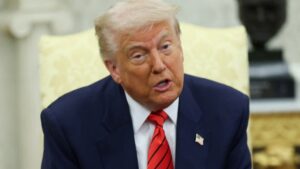—
## Understanding Trade Perspectives: Trump’s Divergent Approach
In a landscape as dynamic as global trade, the recent statements and strategies of U.S. President Donald Trump serve as critical talking points for investors and business leaders alike. During a recent meeting with Canada’s Prime Minister Mark Carney, Trump expressed an unexpected viewpoint: the U.S. does not need to actively “sign deals” with its trading partners. This sentiment flies in the face of what his administration has been promoting for weeks—an aggressive push for bilateral trade agreements.
### A Shift in Rhetoric
President Trump remarked, “Everyone says, ‘when, when, when are you going to sign deals?’” This frustration hints at an underlying strategy that aligns more closely with a posture of strength rather than collaboration. As Trump asserts, “They want a piece of our market. We don’t want a piece of their market.” Herein lies an important aspect of the U.S. trade philosophy: the power dynamics at play favor the U.S. view in negotiations.
Trump’s statements have caused confusion among his advisers, as Treasury Secretary Scott Bessent recently suggested that the U.S. is “very close to some deals,” a stark contrast to the President’s downplaying of immediate agreements.
### The Bigger Picture for Investors
For investors, the inconsistency in trade policy presents both challenges and opportunities. The President’s remarks reflect the delicate interplay between domestic needs and international pressures. As businesses look for clarity, they are met with ambiguity—frequent promises of “soon to come” deals clash with an apparent indecision about the necessity of those deals.
At Extreme Investor Network, we believe it’s crucial to analyze this trade rhetoric not just in isolation but as part of a larger economic strategy. The potential of upcoming deals with significant trading partners like India, South Korea, and Japan could significantly shift market dynamics.
### The Luxury Store Analogy
In an intriguing analogy, Trump described the U.S. as a “super luxury store” where “people are going to have to pay to shop.” This metaphor encapsulates his administration’s view on American markets and the pricing power it holds. What does this mean for investors? Understanding the valuation of U.S. goods in global markets is vital. As the U.S. increasingly positions itself as a premium supplier, prices could rise—affecting demand on both ends of trade negotiations.
### The Ripple Effect on Markets
The immediate response from U.S. markets following Trump’s comments was a noticeable downturn. Investors are feeling the strain as they await concrete outcomes from ongoing discussions. With the threat of tariffs looming ever larger, the need for clarity in trade agreements has never been more pressing. The hesitancy from the Trump administration to formalize these agreements raises questions about the economic ramifications as the global trade climate continues to evolve.
### Conclusion: What Lies Ahead?
As we look to the future, the landscape of international trade under the Trump administration remains uncertain. However, it’s critical to remain engaged and informed. At Extreme Investor Network, we’ll keep you updated on pivotal developments and help you navigate these complex waters. With trade negotiations shaping not only markets but also the U.S. economy at large, leveraging insights into these discussions can position investors to make informed decisions.
In a world where information is power, keep tuning into our analyses to get ahead of the game. Your financial future could depend on it!
—
This blog format provides informative context while enhancing the content with unique perspectives, making it compelling for readers seeking insight from the Extreme Investor Network.

